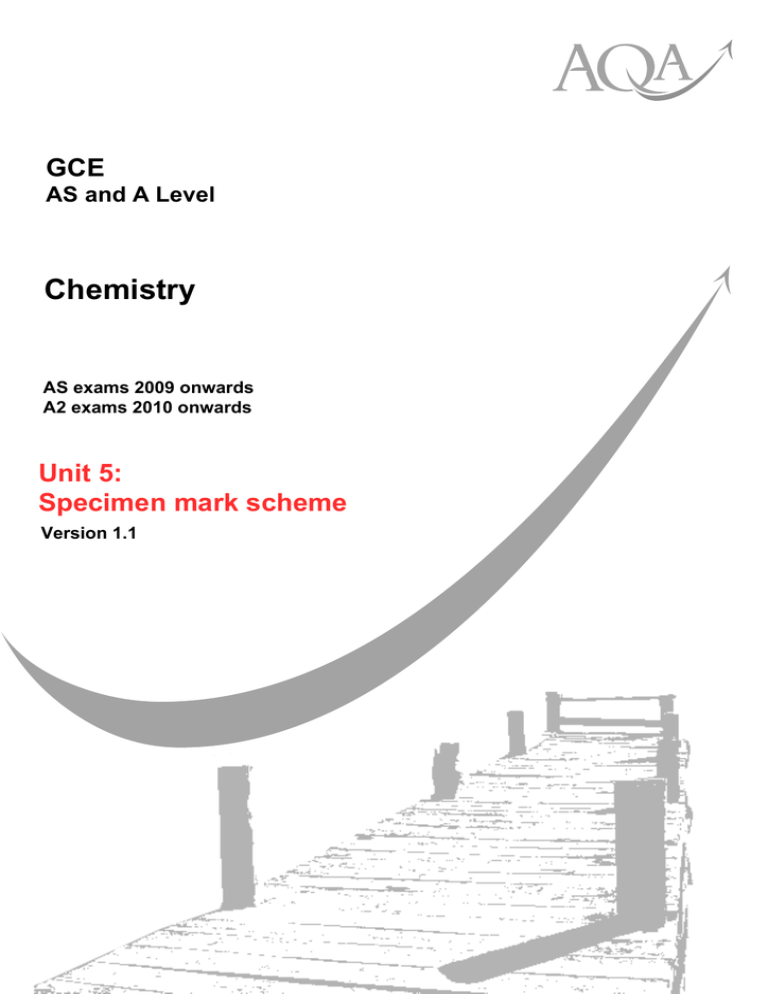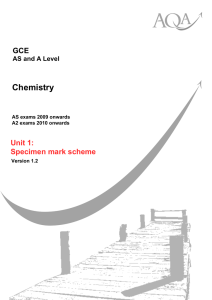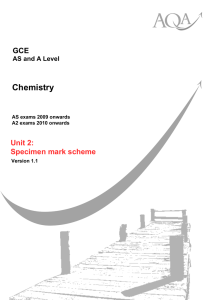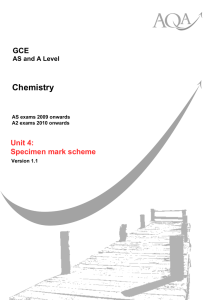
GCE
AS and A Level
Chemistry
AS exams 2009 onwards
A2 exams 2010 onwards
Unit 5:
Specimen mark scheme
Version 1.1
Version 1.1: 02/07
abc
General Certificate of Education
Chemistry 2420
CHEM5
Energetics, Redox and
Inorganic Chemistry
Mark Scheme
Specimen Paper
Mark schemes are prepared by the Principal Examiner and considered, together with the relevant questions, by a
panel of subject teachers. The specimen assessment materials are provided to give centres a reasonable idea of the
general shape and character of the planned question papers and mark schemes in advance of the first operational
exams.
It must be stressed that a mark scheme is a working document, in many cases further developed and expanded on
the basis of candidates’ reactions to a particular paper. Assumptions about future mark schemes on the basis of one
year’s document should be avoided; whilst the guiding principles of assessment remain constant, details will change,
depending on the content of a particular examination paper.
Copyright © 2007 AQA and its licensors. All rights reserved.
COPYRIGHT
AQA retains the copyright on all its publications. However, registered centres for AQA are permitted to copy material
from this booklet for their own internal use, with the following important exception: AQA cannot give permission to
centres to photocopy any material that is acknowledged to a third party even for internal use within the centre.
Set and published by the Assessment and Qualifications Alliance.
The Assessment and Qualifications Alliance (AQA) is a company limited by guarantee registered in England and Wales (company number 3644723) and a registered charity (registered charity number 1073334).
Registered address: AQA, Devas Street, Manchester M15 6EX
Dr Michael Cresswell Director General
GCE CHEMISTRY UNIT 5 SPECIMEN MARK SCHEME/VERSION 1.1
Question 1
(a)
(i)
Oxide 1
Oxide 2
B
E
(1)
(1)
Explanation
Low melting point or weak van der Waals’ forces
between molecules
(1)
Chemical test
Add water
Test pH
(1)
(1)
Observation
pH = 13/14 or colour yellow
(1)
(i)
Equation
CaCO3 → CaO + CO
(1)
(ii)
Product
CaSO3
(1)
(iii)
Disposal of large quantities of CaSO3 (allow CaSO4)
(1)
Produces CO2 or uses up CaCO3
(1)
(ii)
(b)
or
or
flame test
flame colour
Question 2
(a)
(i)
1s2 2s2 2p6 3s2 3p6
(1)
(ii)
The negative S- ion
repels the added electron
(1)
(1)
(iii)
Step B is the atomisation enthalpy of sulfur
(1)
Step D is the second ionisation enthalpy of calcium
(1)
Electrons nearer to the nucleus
(1)
Electrons removed from a positive species or more strongly attracted
(1)
+178 +279 +590 +1145 -200 + 539 + G + 482 = 0
(1)
G +3013 = 0 hence G = -3013
(1)
The model used assumes the ions are spherical and in a lattice
(1)
The calculated value is smaller than the cycle value or stronger attraction
(1)
Indicating some covalent character or ions are polarised
(1)
(iv)
(v)
(b)
3
GCE CHEMISTRY UNIT 5 SPECIMEN MARK SCHEME/VERSION 1.1
(c)
For a reaction to occur ΔG < 0
(1)
ΔS is positive and large as a gas is evolved
(1)
TΔS is larger than ΔH and ΔG is negative
(1)
ΔS is negative
(1)
Four moles gaseous reactant forming or more moles of gaseous product
(1)
At high temperature TΔS is larger than ΔH and ΔG is positive
(1)
(i)
HgO
(1)
(ii)
Hg2+ + 2e- → Hg
(1)
(iii)
2H2O + SO2 → H2SO4 + 2e- etc
(1)
(iv)
Cl2 + 2e- → 2Cl-
(1)
(i)
Vanadium species: VO2+
(1)
Oxidation state: 5
(1)
Half-equation: V2+ + 2H2O → VO2+ + 4H+ + 3e-
(1)
Cell e.m.f 0.06 V
(1)
(1)
(1)
(1)
(i)
(ii)
Question 3
(a)
(b)
(ii)
Change in e.m.f , Increases
More Fe3+ ions to accept electrons
Fe3+/Fe2+ electrode becomes more positive
(c)
(i)
2H2 → 4H+ + 4e-
(1)
4e- + O2 + 2H2O → 4OH-
(1)
Overall equation 2H2 + O2 → 2H2O
(ii)
(d)
(e)
Unchanged
Economic disadvantage; Use of CH4 or cost of producing or high temp
(1)
(1)
Environmental disadvantage;
(1)
Makes CO2
Cost of manufacture of solar cells
4
(1)
GCE CHEMISTRY UNIT 5 SPECIMEN MARK SCHEME/VERSION 1.1
Question 4
(a)
Species
[Co(H2O)6]2+
(1)
Precipitate
Co(H2O)4(OH)2
(1)
(b)
[Co(NH3)6]2+
(c)
Reaction
Oxidation
(1)
(d)
Reactant
R
Oxygen in the air
Iodine
(1)
(1)
Explanation
[Co(H2O)6]3+ oxidises I- to I2
(1)
(1)
Question 5
(a)
Fe + H2SO4 → FeSO4 + H2
-
+
2+
→ Mn
(1)
2+
3+
(b)
MnO4 + 8H + 5Fe
+ 4H2O + 5Fe
(c)
Moles MnO4- in 19.6 cm3
= 19.6 × 0.022 × 10-3 = 4.312 ×10-4
(1)
Moles Fe2+ in 25 cm3
= 5 × 4.312 × 10-4 = 2.156 × 10-3
(1)
Moles Fe2+ in 250 cm3
= 10 × 2.156 × 10-3 = 2.156 × 10-2
(1)
Mass Fe2+ = moles × Ar
Ar = 2.156 × 10-2 × 55.8 = 1.203g
(1)
Percentage by mass of carbon
= (1.270 - 1.203) × 100/1.270
= 5.28%
(1)
(d)
Repeat the titration and take an average of the concordant results
(1)
(e)
Analyse several samples from different parts of the molten iron
(1)
5
(1)
GCE CHEMISTRY UNIT 5 SPECIMEN MARK SCHEME/VERSION 1.1
Question 6
(a)
Equation:
e.g. [Cu(H2O)6]2+ + 4Cl- → [CuCl4]2- + 6H2O
(1)
(1)
Species
Balance
Colours:
e.g [Cu(H2O)6]2+
e.g. [CuCl4]2(b)
(i)
(ii)
blue
yellow/green
(1)
(1)
ΔE :-
The energy absorbed
(1)
h:-
Planck’s constant
(1)
Factor 1
Factor 2
Factor 3
Change of ligand
Change in oxidation state
Change in co-ordination number
(1)
(1)
(1)
Equation
1/2N2 + 3/2H2 ∅ NH3
(1)
= [(945 ∞ 0.5) + (426 ∞ 1.5)] - (391 ∞ 3)
(1)
= - 46.5 kJ mol-1
(1)
Question 7
(a)
ΔHf
Mark
Range
The marking scheme for this part of the question includes an overall assessment
for the Quality of Written Communication (QWC). There are no discrete marks
for the assessment of QWC but the candidates’ QWC in this answer will be one of
the criteria used to assign a level and award the marks for this part of the question
Descriptor
an answer will be expected to meet most of the criteria in the level descriptor
4-5
- claims supported by an appropriate range of evidence
- good use of information or ideas about chemistry, going beyond those given in
- the question
argument well structured with minimal repetition or irrelevant points
2-3
accurate and clear expression of ideas with only minor errors of grammar,
punctuation and spelling
- claims partially supported by evidence
- good use of information or ideas about chemistry given in the question but
- limited beyond this
the argument shows some attempt at structure
0-1
the ideas are expressed with reasonable clarity but with a few errors of
grammar, punctuation and spelling
- valid points but not clearly linked to an argument structure
6
GCE CHEMISTRY UNIT 5 SPECIMEN MARK SCHEME/VERSION 1.1
- limited use of information or ideas about chemistry
- unstructured
- errors in spelling, punctuation and grammar or lack of fluency
(b)
The higher the temperature the faster the reaction
QWC
(1)
but, since the reaction is exothermic
the equilibrium yield is lower
QWC
(1)
(1)
The higher the pressure the greater the equilibrium yield
QWC
because there is a reduction in the number of moles of gas in the reaction
but higher pressure is expensive to produce or plant is more expensive to
build
QWC
A better catalyst would lessen the time to reach equilibrium
and allow more ammonia to be produced in a given time
QWC
(1)
(1)
(1)
(1)
(1)
Question 8
(a)
(b)
(c)
(i)
FeCl3 accepts electron pairs from water
(1)
Hence acts as a Lewis acid
(1)
[Fe(H2O)6]3+ donates protons
(1)
Hence acts as a Bronsted-Lowry acid
(1)
The Fe2+ ion has a smaller charge to size ratio
(1)
Hence less polarising than Fe3+ or less weakening effect on O-H bonds
(1)
V2O5 + SO2 ∅ V2O4 + SO3
(1)
V2O4 + O2 ∅ V2O5
(1)
7
GCE CHEMISTRY UNIT 5 SPECIMEN MARK SCHEME/VERSION 1.1
(ii)
Both ions are negative or ions repel
2Fe2+ + S2O822Fe3+ + 2I-
∅
∅
(1)
2Fe3+ + 2SO42-
2Fe2+ + I2
Species
Balanced
(1)
(1)
Species
Balanced
(1)
(1)
Question 9
A chlorine atom has more protons in its nucleus than has a sodium atom
(1)
Both have three shells of electrons
(1)
Electrons more strongly attracted by chlorine nucleus so size smaller than Na
(1)
An electron shell is lost when a sodium ion is formed from a sodium atom
(1)
Inner electrons more strongly attracted so ion smaller than atom
(1)
An electron is added to the outer shell when a chloride ion is formed
(1)
Greater repulsion between shells so size of chloride ion greater than Cl atom
MAX 6
QWC
8
(1)






